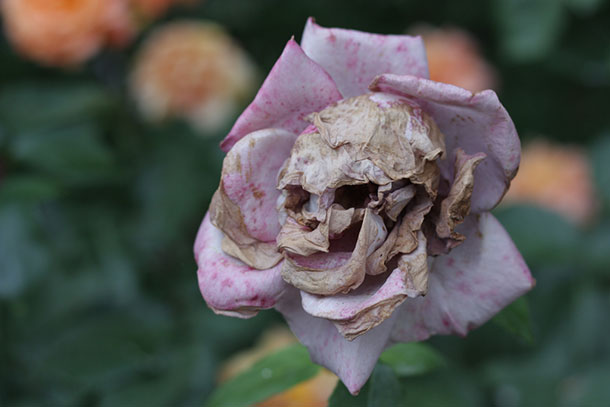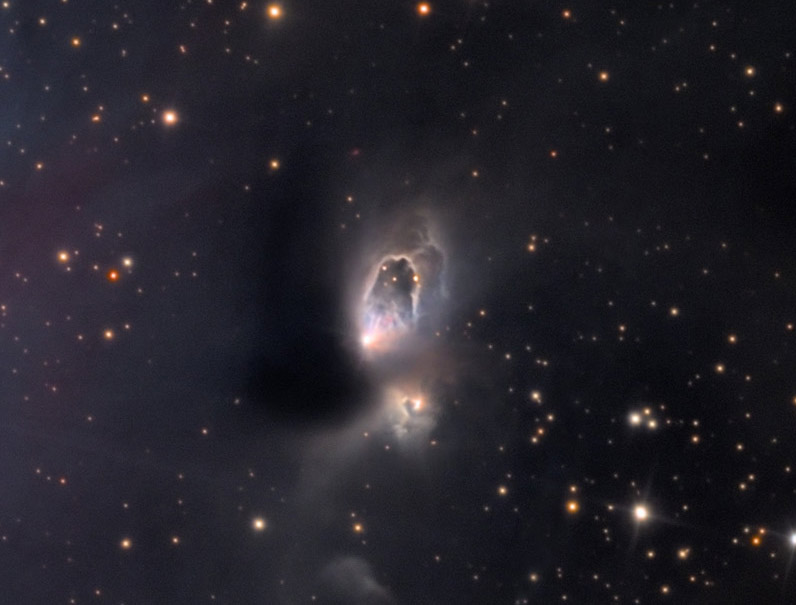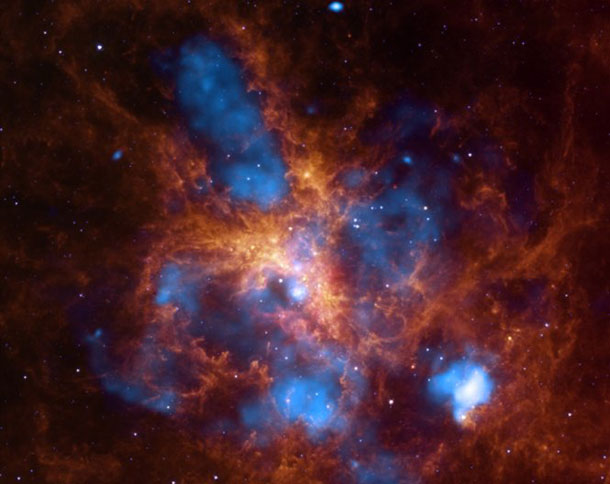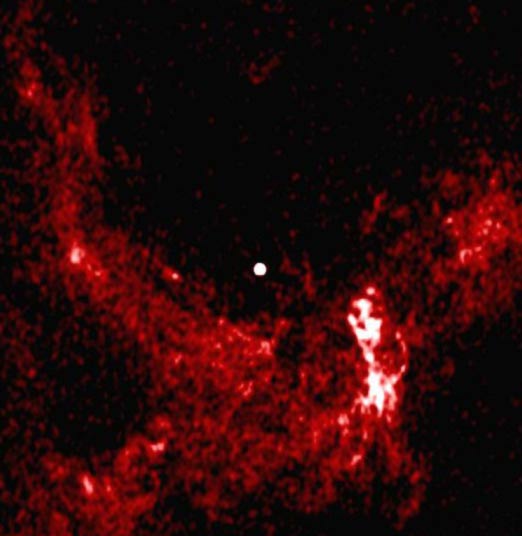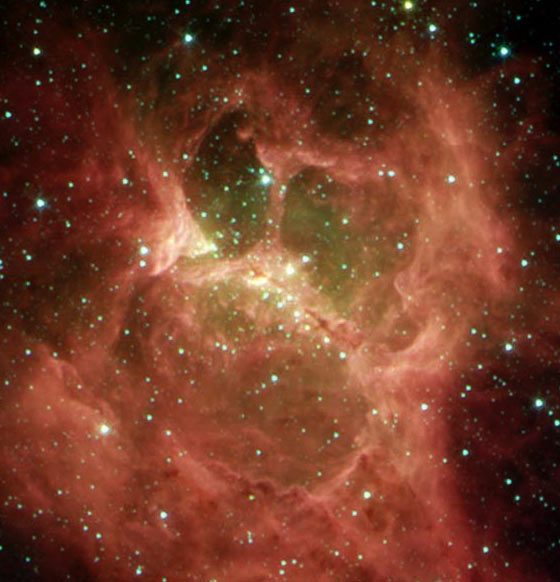Angry nebula is really REALLY angry
In the heart of the Large Magellanic Cloud (one of the Milky Way's many satellite galaxies), there lies a vast complex of gas called 30 Doradus. And inside that sprawling volume of space is the Tarantula Nebula, a star-forming region so huge it dwarfs even our own Orion Nebula. Thousands of stars are churning away in there, going through the process of being born.
And as they do, the hottest and brightest of them carve huge cavities in the nebula, heating the tenuous gas therein to millions of degrees. The result? This:
[Click to embiggen.]
I love this image! It's a combination of observations from the Chandra X-Ray Observatory (in blue, showing the incredibly hot gas) and from Spitzer Space Telescope (in red, showing cooler gas). Those bubbles of hot, X-ray emitting gas are constrained by the cooler gas around them, but it's likely the hot gas is expanding, driving the overall expansion of the nebula itself. However, it's also possible the sheer flood of high-energy radiation from the nascent stars is behind the gas's expansion... or it's a combination of both. Astronomers are still arguing over this, and observations like this one will help figure out who's right.
... but you know me. I love pareidolia, and there's no way you can look at this image and not see a really angry screaming face, shrieking at that blue blob hovering in its way. That's so cool!
And c'mon, NASA: you release this image two weeks after Halloween? Oh well, I'll add it to my scary astronomy gallery anyway, which is after the jump below.
Image credit: X-ray: NASA/CXC/PSU/L.Townsley et al.; Infrared: NASA/JPL/PSU/L.Townsley et al.
Bad Astronomy Gallery
(click any image to see it full size)
Actually, it's something far scarier: a gigantic black hole gobbling down matter and spewing out vast amounts of high-energy radiation.
In the heart of the Perseus cluster of galaxies lies the monster Perseus A, a huge galaxy that is blasting out X-rays. In this image by the orbiting Chandra X-ray Observatory, the galaxy is between the two "eyes", which are most likely gigantic bubbles of gas expanding away from the supermassive black hole at the heart of the galaxy. Those dark regions are each half the size of our own Milky Way galaxy, 100,000 light years across!
Image credit: NASA, IoA, A. Fabian et al.
Original blog post: Cosmically creepy chords (about emissions from space translated into sounds that are honestly pretty cool)
[... and yes, it's a real picture!]
Image credit: Todd Terwilliger, used by permission
Original blog post
This image was taken by astrophotographer Rogelio Andreo, and was a small piece of a vast Orion mosaic he made. It was so incredibly beautiful that I picked it as my Number 1 Astronomy picture of 2010.
Image credit: Rogelio Andreo
Original blog post: The Top 14 Astronomy Pictures of 2010
This is one of my favorite nebulae in the sky, and if it looks familiar, it should: in a bizarre - and literal - twist of fate, it's actually the picture of the Witch Head Nebula turned sideways!
I love that you can take an astronomical picture related to Halloween, turn it 90 degrees, and get a different Halloween picture! Turn your head to the left to see the Witch.
If you have a hard time seeing it, the ghost is running to the right; the upswept arc on the right is his arm (the Witch's chin), his head is the bump to the left (the Witch's lip), his other arm is the arc on the left (the Witch's nose), and his ghostly feet dangle below.
Image credit: Rogelio Andreo
Original blog post: The Top 14 Astronomy Pictures of 2010
This is a small part of a much larger and fantastically beautiful image of the region around the nebula vdB1, and I really recommend you take a look. It's breath-taking.
Adam Block/Mount Lemmon Sky Center/University of Arizona
Original image
And if that were happening inside of you, I imagine you'd be screaming in fury as well.
Man, that is one ticked off nebula. I'm glad it's so far away.
Image credit: X-ray: NASA/CXC/PSU/L.Townsley et al.; Infrared: NASA/JPL/PSU/L.Townsley et al.
One, though, must've suffered an error during the DNA transcription. Unless there's some evolutionary benefit for an aspen tree to have a bleeding eye in its trunk.
And if that's the case, I don't think I wanna know.
Image credit: me!
But c'mon, look at it! How could I not include it?
Image credit: Icelandic Coastal Patrol
Original blog post: Blowin' off some scream
This is SH2-136, a Bok globule, a dark blob of gas that forms stars deep within. Parts of it are lit up by nearby stars, allowing us to witness this act of cosmic trick-or-treatery.
Image credit: Adam Block/NOAO/AURA/NSF
Original: SH2-136
Or is that your conscience speaking? This is actually a star-forming cloud called NGC 2467, as seen by the MPG/ESO telescope in Chile. Each eye is actually a cluster of stars, blowing huge holes in the gas cloud, forming what looks like two colorful eyes burning a hole into your very soul.
I have to note: this object is in the constellation of Puppis, the stern of a cosmic ship. So this really is a stern glare!
Image credit: ESO
Original image: The cosmic Christmas ghost
But really it's a vast cloud of gas furiously churning out stars. The winds of subatomic particles and fierce light from those newborn stars carve out cavities in the gas, leaving what look like eye sockets and a nasal bone in a huge green skull.
I have to say... it looks a lot like the very creepy aliens called "The Silence" from Doctor Who.
This image was taken by astronomer César Cantú, who has dozens of other stunning astronomical photos on his site... but none quite so creepy.
Image credit: César Cantú
Original blog post: Heart and Skull nebula
Perhaps she perceives her own fate: being twisted around, the gas making up her visage warped and wrapped as it circles that black hole over thousands of years, eventually, it may be, to take the final plunge into eterity.
Image credit: Zhao & Goss, using the VLA radio telescope
Original image: Introduction to Radio Astronomy
This is an infrared Spitzer Space Telescope image of the gas cloud, which is forming a dozen or so stars inside it. The eyes and mouth are bubbles in the gas blown by the winds of the newborn stars.
So in a way, it really is yelling. But at a distance of 4000 light years - and across the vacuum of space - there's nothing we can hear.
Except: BOO!
Image credit: NASA/JPL-Caltech/S. Carey (Caltech)
Original image: Star formation region DR 6




